HA2011 Managerial Accounting
VerifiedAdded on 2021/06/17
|16
|3520
|32
AI Summary
Contribute Materials
Your contribution can guide someone’s learning journey. Share your
documents today.
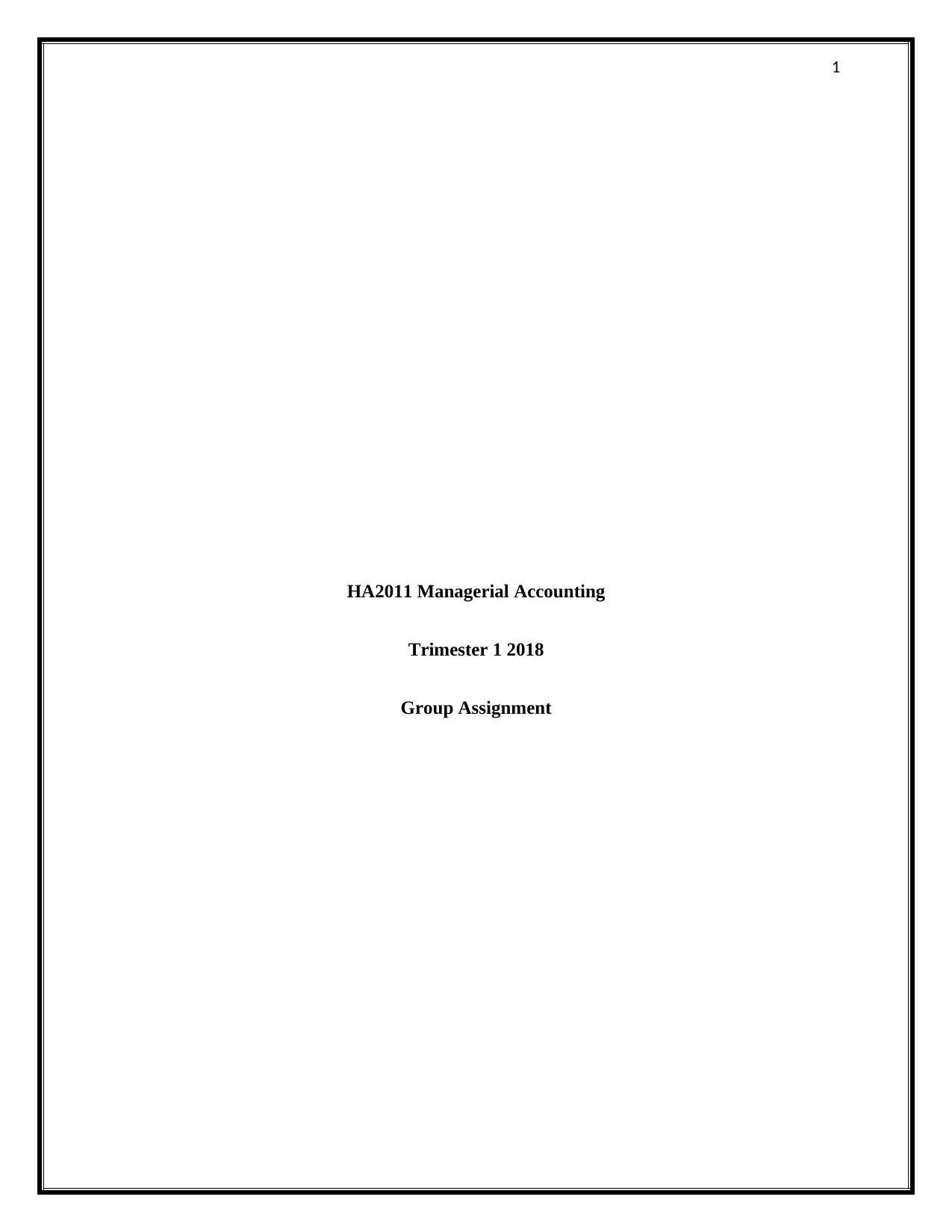
1
HA2011 Managerial Accounting
Trimester 1 2018
Group Assignment
HA2011 Managerial Accounting
Trimester 1 2018
Group Assignment
Secure Best Marks with AI Grader
Need help grading? Try our AI Grader for instant feedback on your assignments.
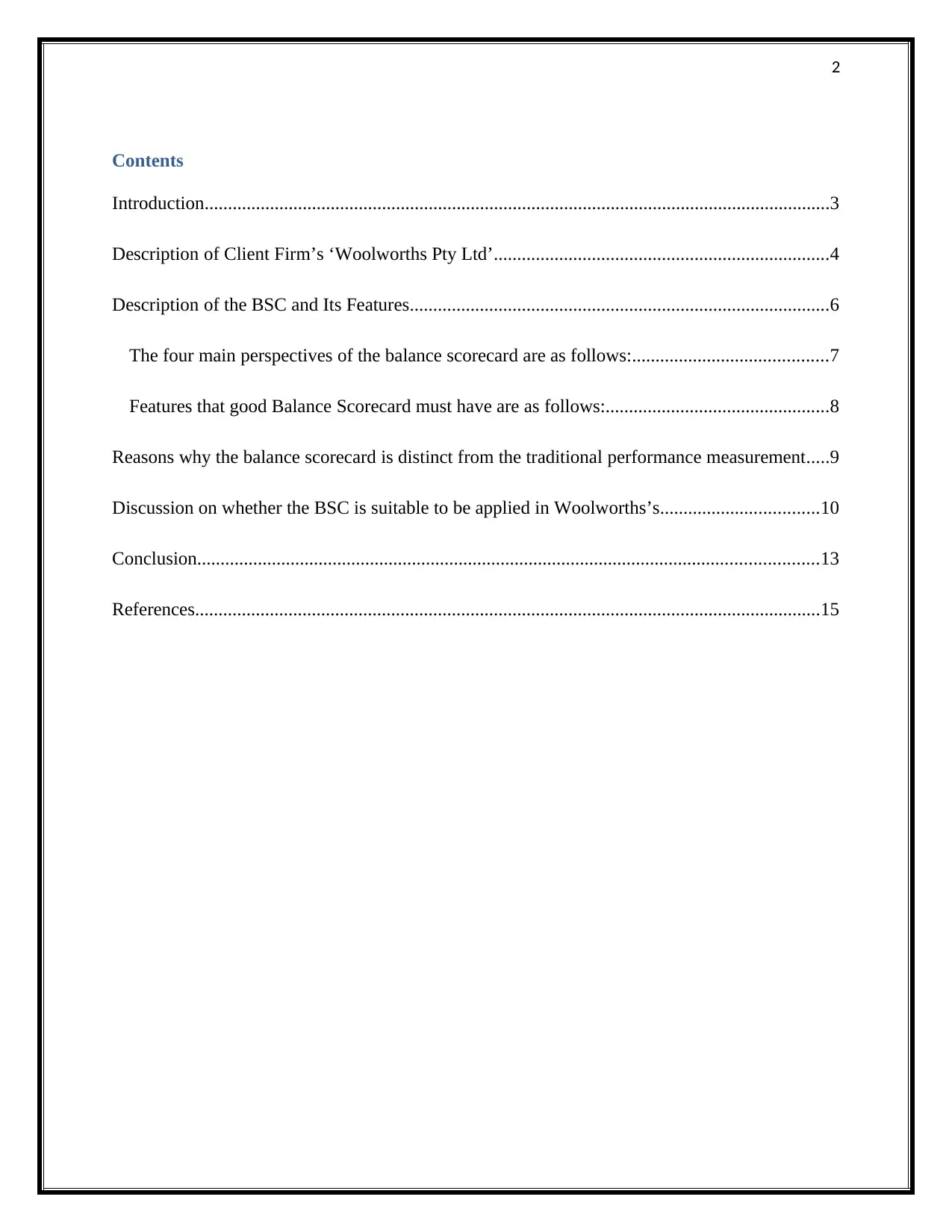
2
Contents
Introduction......................................................................................................................................3
Description of Client Firm’s ‘Woolworths Pty Ltd’........................................................................4
Description of the BSC and Its Features..........................................................................................6
The four main perspectives of the balance scorecard are as follows:..........................................7
Features that good Balance Scorecard must have are as follows:................................................8
Reasons why the balance scorecard is distinct from the traditional performance measurement.....9
Discussion on whether the BSC is suitable to be applied in Woolworths’s..................................10
Conclusion.....................................................................................................................................13
References......................................................................................................................................15
Contents
Introduction......................................................................................................................................3
Description of Client Firm’s ‘Woolworths Pty Ltd’........................................................................4
Description of the BSC and Its Features..........................................................................................6
The four main perspectives of the balance scorecard are as follows:..........................................7
Features that good Balance Scorecard must have are as follows:................................................8
Reasons why the balance scorecard is distinct from the traditional performance measurement.....9
Discussion on whether the BSC is suitable to be applied in Woolworths’s..................................10
Conclusion.....................................................................................................................................13
References......................................................................................................................................15
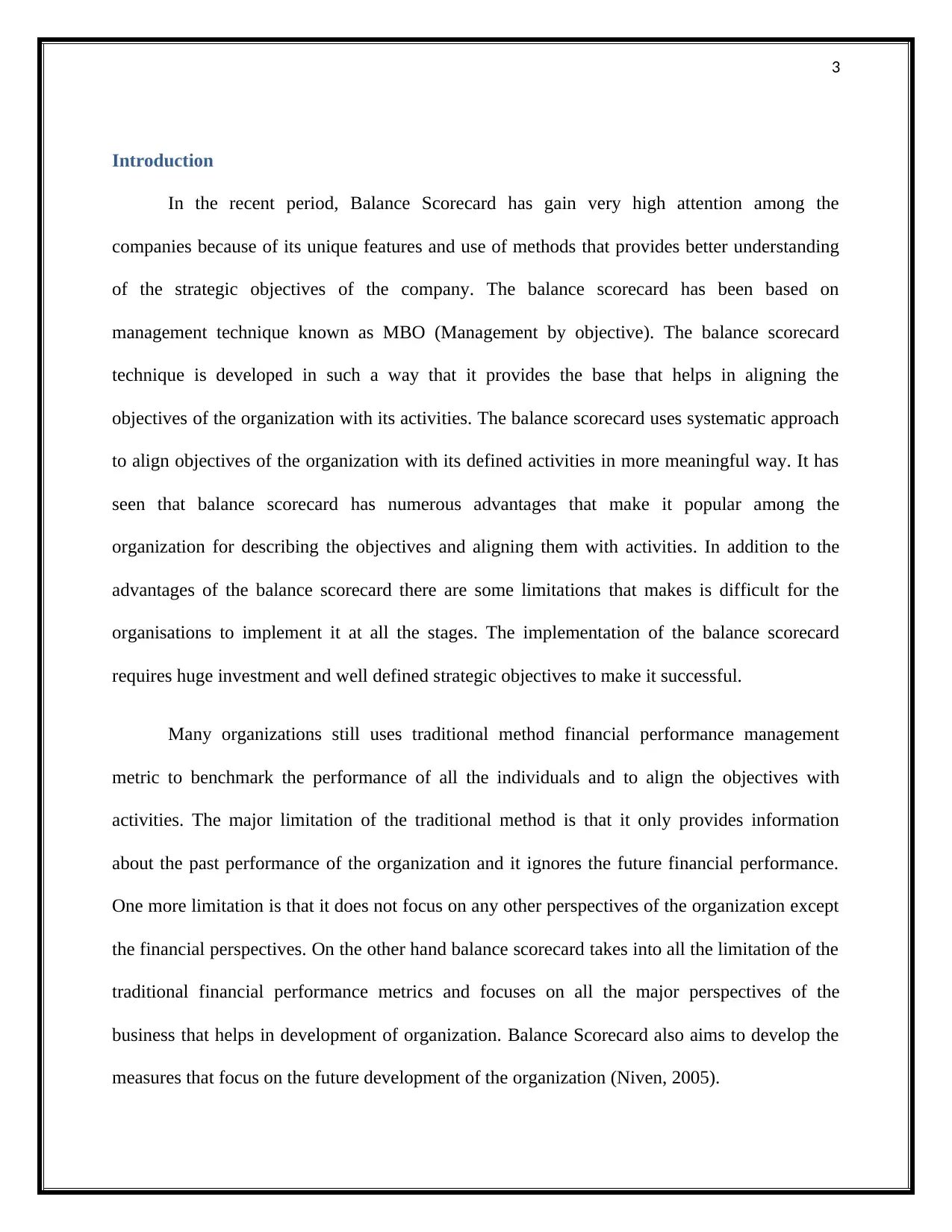
3
Introduction
In the recent period, Balance Scorecard has gain very high attention among the
companies because of its unique features and use of methods that provides better understanding
of the strategic objectives of the company. The balance scorecard has been based on
management technique known as MBO (Management by objective). The balance scorecard
technique is developed in such a way that it provides the base that helps in aligning the
objectives of the organization with its activities. The balance scorecard uses systematic approach
to align objectives of the organization with its defined activities in more meaningful way. It has
seen that balance scorecard has numerous advantages that make it popular among the
organization for describing the objectives and aligning them with activities. In addition to the
advantages of the balance scorecard there are some limitations that makes is difficult for the
organisations to implement it at all the stages. The implementation of the balance scorecard
requires huge investment and well defined strategic objectives to make it successful.
Many organizations still uses traditional method financial performance management
metric to benchmark the performance of all the individuals and to align the objectives with
activities. The major limitation of the traditional method is that it only provides information
about the past performance of the organization and it ignores the future financial performance.
One more limitation is that it does not focus on any other perspectives of the organization except
the financial perspectives. On the other hand balance scorecard takes into all the limitation of the
traditional financial performance metrics and focuses on all the major perspectives of the
business that helps in development of organization. Balance Scorecard also aims to develop the
measures that focus on the future development of the organization (Niven, 2005).
Introduction
In the recent period, Balance Scorecard has gain very high attention among the
companies because of its unique features and use of methods that provides better understanding
of the strategic objectives of the company. The balance scorecard has been based on
management technique known as MBO (Management by objective). The balance scorecard
technique is developed in such a way that it provides the base that helps in aligning the
objectives of the organization with its activities. The balance scorecard uses systematic approach
to align objectives of the organization with its defined activities in more meaningful way. It has
seen that balance scorecard has numerous advantages that make it popular among the
organization for describing the objectives and aligning them with activities. In addition to the
advantages of the balance scorecard there are some limitations that makes is difficult for the
organisations to implement it at all the stages. The implementation of the balance scorecard
requires huge investment and well defined strategic objectives to make it successful.
Many organizations still uses traditional method financial performance management
metric to benchmark the performance of all the individuals and to align the objectives with
activities. The major limitation of the traditional method is that it only provides information
about the past performance of the organization and it ignores the future financial performance.
One more limitation is that it does not focus on any other perspectives of the organization except
the financial perspectives. On the other hand balance scorecard takes into all the limitation of the
traditional financial performance metrics and focuses on all the major perspectives of the
business that helps in development of organization. Balance Scorecard also aims to develop the
measures that focus on the future development of the organization (Niven, 2005).
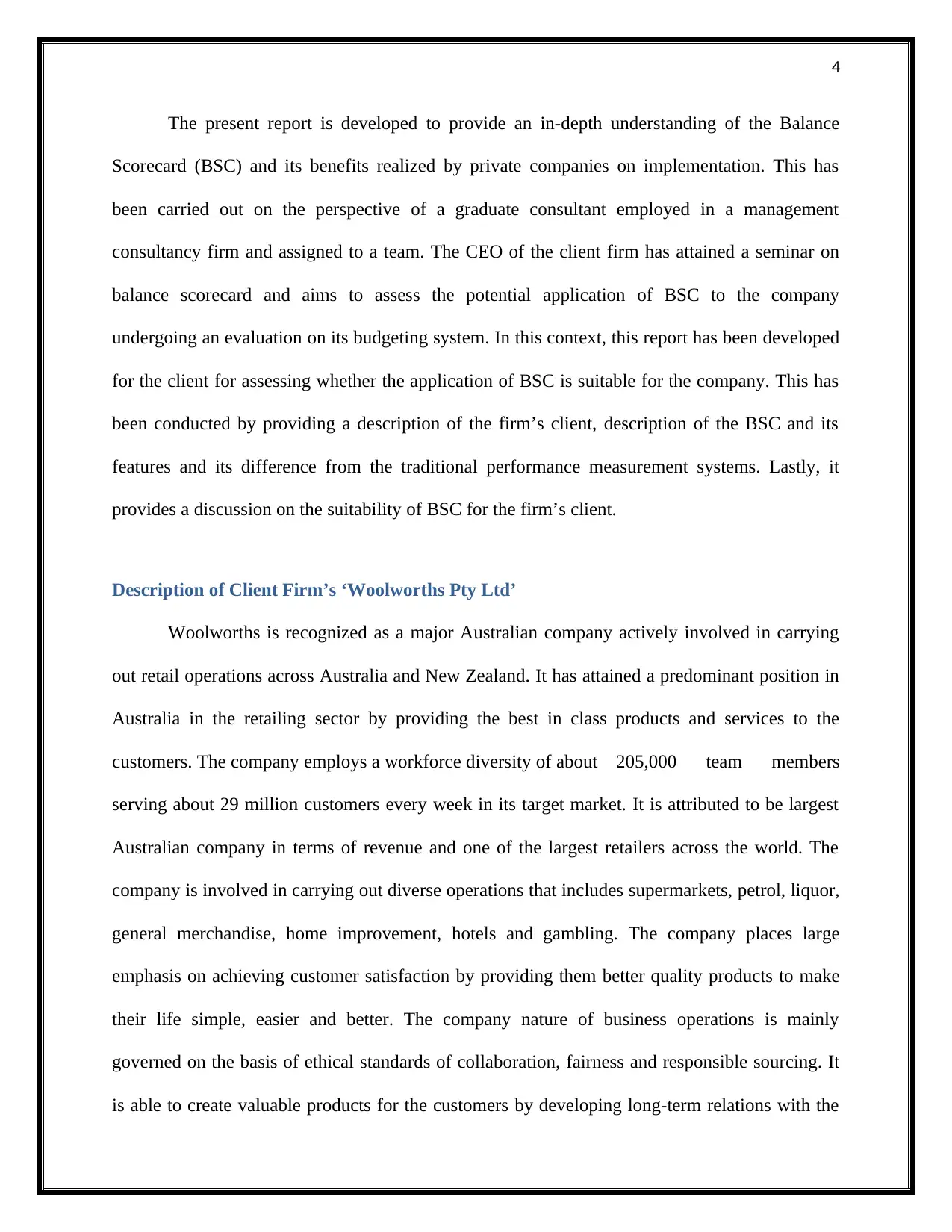
4
The present report is developed to provide an in-depth understanding of the Balance
Scorecard (BSC) and its benefits realized by private companies on implementation. This has
been carried out on the perspective of a graduate consultant employed in a management
consultancy firm and assigned to a team. The CEO of the client firm has attained a seminar on
balance scorecard and aims to assess the potential application of BSC to the company
undergoing an evaluation on its budgeting system. In this context, this report has been developed
for the client for assessing whether the application of BSC is suitable for the company. This has
been conducted by providing a description of the firm’s client, description of the BSC and its
features and its difference from the traditional performance measurement systems. Lastly, it
provides a discussion on the suitability of BSC for the firm’s client.
Description of Client Firm’s ‘Woolworths Pty Ltd’
Woolworths is recognized as a major Australian company actively involved in carrying
out retail operations across Australia and New Zealand. It has attained a predominant position in
Australia in the retailing sector by providing the best in class products and services to the
customers. The company employs a workforce diversity of about 205,000 team members
serving about 29 million customers every week in its target market. It is attributed to be largest
Australian company in terms of revenue and one of the largest retailers across the world. The
company is involved in carrying out diverse operations that includes supermarkets, petrol, liquor,
general merchandise, home improvement, hotels and gambling. The company places large
emphasis on achieving customer satisfaction by providing them better quality products to make
their life simple, easier and better. The company nature of business operations is mainly
governed on the basis of ethical standards of collaboration, fairness and responsible sourcing. It
is able to create valuable products for the customers by developing long-term relations with the
The present report is developed to provide an in-depth understanding of the Balance
Scorecard (BSC) and its benefits realized by private companies on implementation. This has
been carried out on the perspective of a graduate consultant employed in a management
consultancy firm and assigned to a team. The CEO of the client firm has attained a seminar on
balance scorecard and aims to assess the potential application of BSC to the company
undergoing an evaluation on its budgeting system. In this context, this report has been developed
for the client for assessing whether the application of BSC is suitable for the company. This has
been conducted by providing a description of the firm’s client, description of the BSC and its
features and its difference from the traditional performance measurement systems. Lastly, it
provides a discussion on the suitability of BSC for the firm’s client.
Description of Client Firm’s ‘Woolworths Pty Ltd’
Woolworths is recognized as a major Australian company actively involved in carrying
out retail operations across Australia and New Zealand. It has attained a predominant position in
Australia in the retailing sector by providing the best in class products and services to the
customers. The company employs a workforce diversity of about 205,000 team members
serving about 29 million customers every week in its target market. It is attributed to be largest
Australian company in terms of revenue and one of the largest retailers across the world. The
company is involved in carrying out diverse operations that includes supermarkets, petrol, liquor,
general merchandise, home improvement, hotels and gambling. The company places large
emphasis on achieving customer satisfaction by providing them better quality products to make
their life simple, easier and better. The company nature of business operations is mainly
governed on the basis of ethical standards of collaboration, fairness and responsible sourcing. It
is able to create valuable products for the customers by developing long-term relations with the
Secure Best Marks with AI Grader
Need help grading? Try our AI Grader for instant feedback on your assignments.
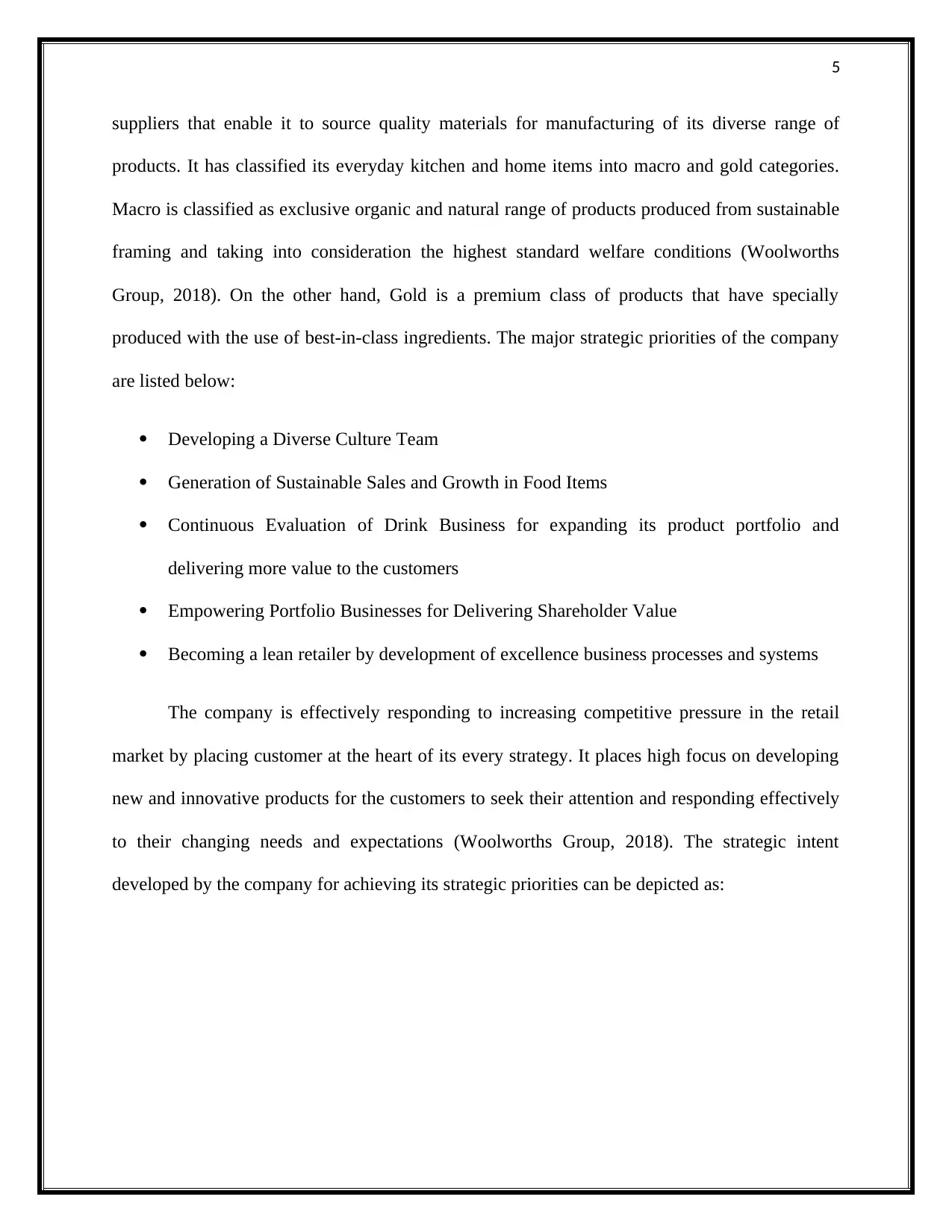
5
suppliers that enable it to source quality materials for manufacturing of its diverse range of
products. It has classified its everyday kitchen and home items into macro and gold categories.
Macro is classified as exclusive organic and natural range of products produced from sustainable
framing and taking into consideration the highest standard welfare conditions (Woolworths
Group, 2018). On the other hand, Gold is a premium class of products that have specially
produced with the use of best-in-class ingredients. The major strategic priorities of the company
are listed below:
Developing a Diverse Culture Team
Generation of Sustainable Sales and Growth in Food Items
Continuous Evaluation of Drink Business for expanding its product portfolio and
delivering more value to the customers
Empowering Portfolio Businesses for Delivering Shareholder Value
Becoming a lean retailer by development of excellence business processes and systems
The company is effectively responding to increasing competitive pressure in the retail
market by placing customer at the heart of its every strategy. It places high focus on developing
new and innovative products for the customers to seek their attention and responding effectively
to their changing needs and expectations (Woolworths Group, 2018). The strategic intent
developed by the company for achieving its strategic priorities can be depicted as:
suppliers that enable it to source quality materials for manufacturing of its diverse range of
products. It has classified its everyday kitchen and home items into macro and gold categories.
Macro is classified as exclusive organic and natural range of products produced from sustainable
framing and taking into consideration the highest standard welfare conditions (Woolworths
Group, 2018). On the other hand, Gold is a premium class of products that have specially
produced with the use of best-in-class ingredients. The major strategic priorities of the company
are listed below:
Developing a Diverse Culture Team
Generation of Sustainable Sales and Growth in Food Items
Continuous Evaluation of Drink Business for expanding its product portfolio and
delivering more value to the customers
Empowering Portfolio Businesses for Delivering Shareholder Value
Becoming a lean retailer by development of excellence business processes and systems
The company is effectively responding to increasing competitive pressure in the retail
market by placing customer at the heart of its every strategy. It places high focus on developing
new and innovative products for the customers to seek their attention and responding effectively
to their changing needs and expectations (Woolworths Group, 2018). The strategic intent
developed by the company for achieving its strategic priorities can be depicted as:
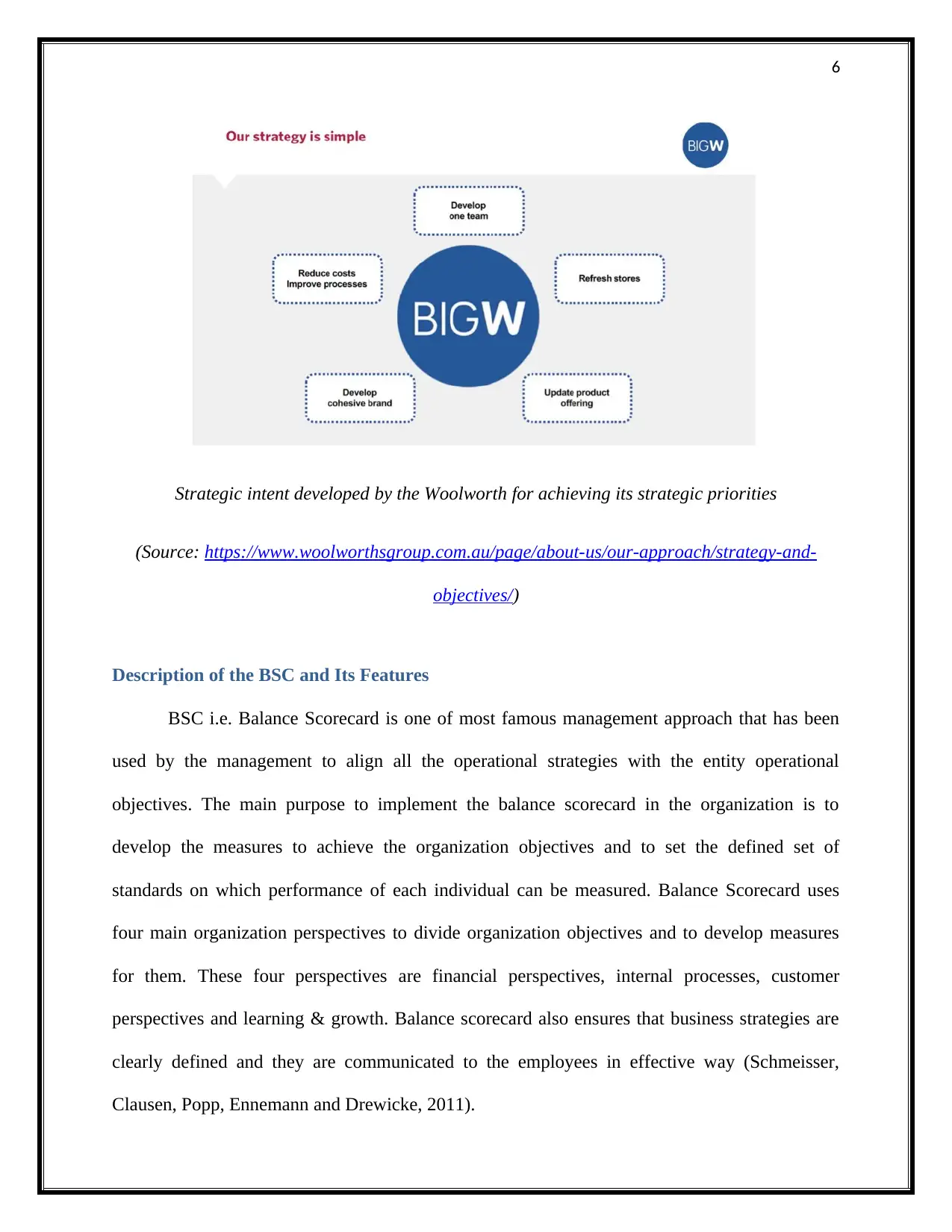
6
Strategic intent developed by the Woolworth for achieving its strategic priorities
(Source: https://www.woolworthsgroup.com.au/page/about-us/our-approach/strategy-and-
objectives/)
Description of the BSC and Its Features
BSC i.e. Balance Scorecard is one of most famous management approach that has been
used by the management to align all the operational strategies with the entity operational
objectives. The main purpose to implement the balance scorecard in the organization is to
develop the measures to achieve the organization objectives and to set the defined set of
standards on which performance of each individual can be measured. Balance Scorecard uses
four main organization perspectives to divide organization objectives and to develop measures
for them. These four perspectives are financial perspectives, internal processes, customer
perspectives and learning & growth. Balance scorecard also ensures that business strategies are
clearly defined and they are communicated to the employees in effective way (Schmeisser,
Clausen, Popp, Ennemann and Drewicke, 2011).
Strategic intent developed by the Woolworth for achieving its strategic priorities
(Source: https://www.woolworthsgroup.com.au/page/about-us/our-approach/strategy-and-
objectives/)
Description of the BSC and Its Features
BSC i.e. Balance Scorecard is one of most famous management approach that has been
used by the management to align all the operational strategies with the entity operational
objectives. The main purpose to implement the balance scorecard in the organization is to
develop the measures to achieve the organization objectives and to set the defined set of
standards on which performance of each individual can be measured. Balance Scorecard uses
four main organization perspectives to divide organization objectives and to develop measures
for them. These four perspectives are financial perspectives, internal processes, customer
perspectives and learning & growth. Balance scorecard also ensures that business strategies are
clearly defined and they are communicated to the employees in effective way (Schmeisser,
Clausen, Popp, Ennemann and Drewicke, 2011).
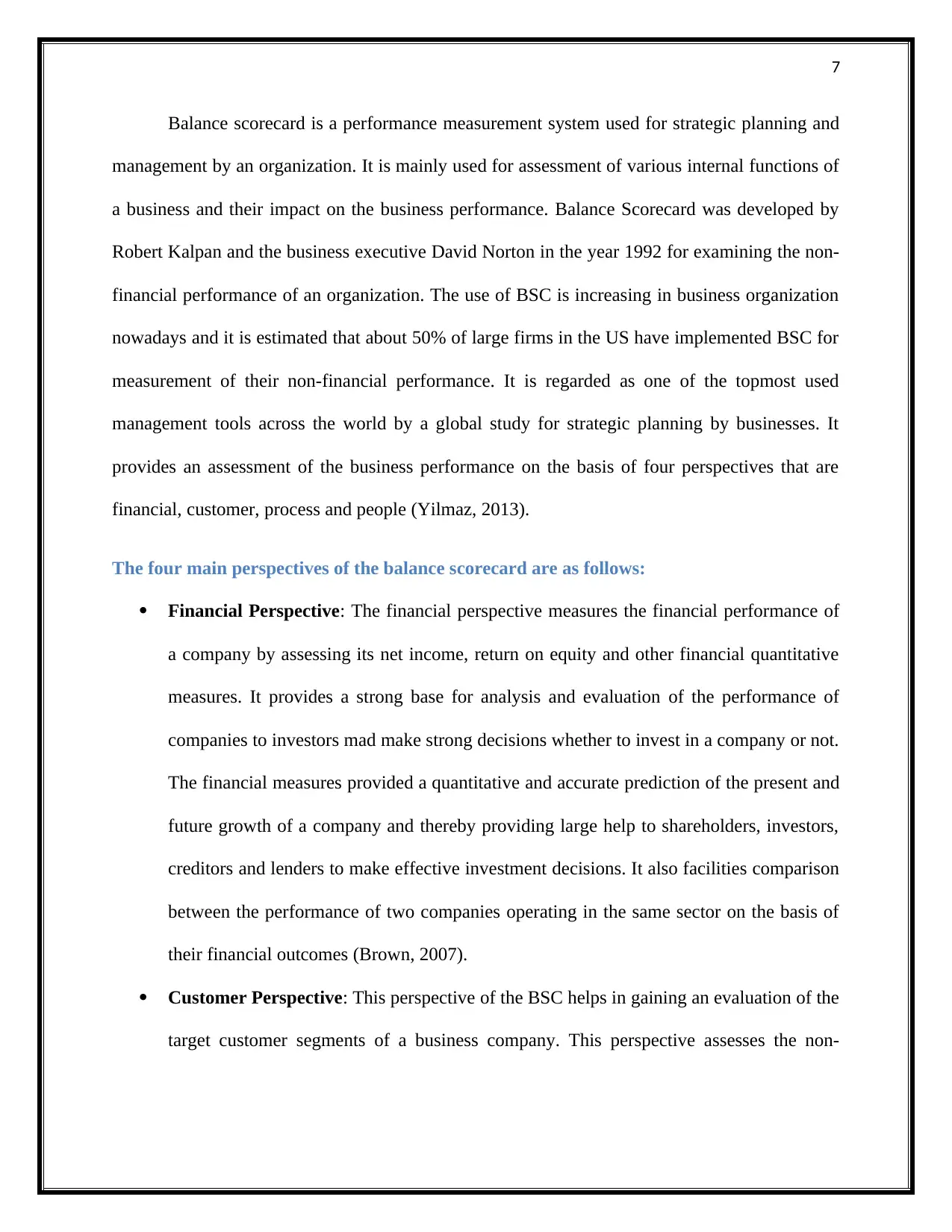
7
Balance scorecard is a performance measurement system used for strategic planning and
management by an organization. It is mainly used for assessment of various internal functions of
a business and their impact on the business performance. Balance Scorecard was developed by
Robert Kalpan and the business executive David Norton in the year 1992 for examining the non-
financial performance of an organization. The use of BSC is increasing in business organization
nowadays and it is estimated that about 50% of large firms in the US have implemented BSC for
measurement of their non-financial performance. It is regarded as one of the topmost used
management tools across the world by a global study for strategic planning by businesses. It
provides an assessment of the business performance on the basis of four perspectives that are
financial, customer, process and people (Yilmaz, 2013).
The four main perspectives of the balance scorecard are as follows:
Financial Perspective: The financial perspective measures the financial performance of
a company by assessing its net income, return on equity and other financial quantitative
measures. It provides a strong base for analysis and evaluation of the performance of
companies to investors mad make strong decisions whether to invest in a company or not.
The financial measures provided a quantitative and accurate prediction of the present and
future growth of a company and thereby providing large help to shareholders, investors,
creditors and lenders to make effective investment decisions. It also facilities comparison
between the performance of two companies operating in the same sector on the basis of
their financial outcomes (Brown, 2007).
Customer Perspective: This perspective of the BSC helps in gaining an evaluation of the
target customer segments of a business company. This perspective assesses the non-
Balance scorecard is a performance measurement system used for strategic planning and
management by an organization. It is mainly used for assessment of various internal functions of
a business and their impact on the business performance. Balance Scorecard was developed by
Robert Kalpan and the business executive David Norton in the year 1992 for examining the non-
financial performance of an organization. The use of BSC is increasing in business organization
nowadays and it is estimated that about 50% of large firms in the US have implemented BSC for
measurement of their non-financial performance. It is regarded as one of the topmost used
management tools across the world by a global study for strategic planning by businesses. It
provides an assessment of the business performance on the basis of four perspectives that are
financial, customer, process and people (Yilmaz, 2013).
The four main perspectives of the balance scorecard are as follows:
Financial Perspective: The financial perspective measures the financial performance of
a company by assessing its net income, return on equity and other financial quantitative
measures. It provides a strong base for analysis and evaluation of the performance of
companies to investors mad make strong decisions whether to invest in a company or not.
The financial measures provided a quantitative and accurate prediction of the present and
future growth of a company and thereby providing large help to shareholders, investors,
creditors and lenders to make effective investment decisions. It also facilities comparison
between the performance of two companies operating in the same sector on the basis of
their financial outcomes (Brown, 2007).
Customer Perspective: This perspective of the BSC helps in gaining an evaluation of the
target customer segments of a business company. This perspective assesses the non-
Paraphrase This Document
Need a fresh take? Get an instant paraphrase of this document with our AI Paraphraser
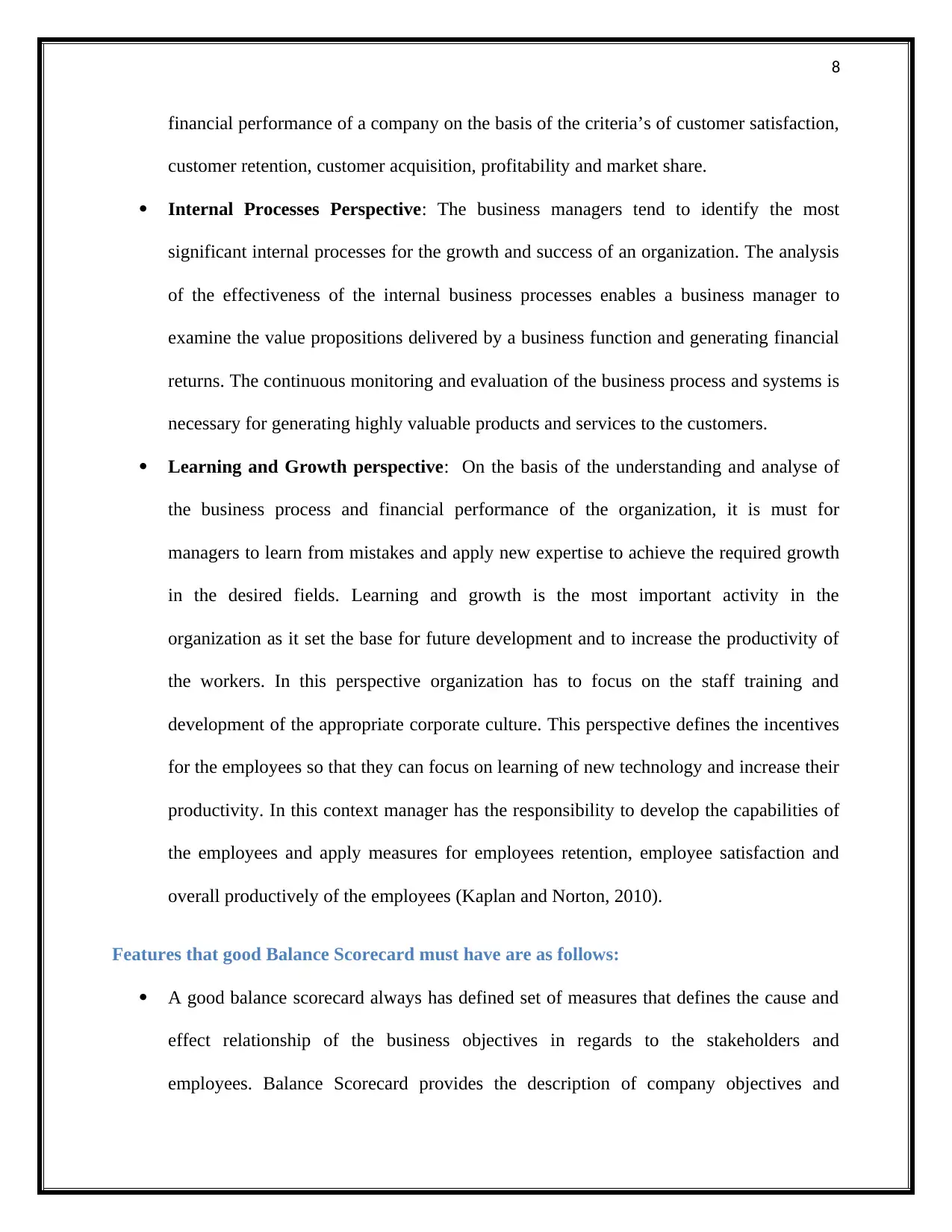
8
financial performance of a company on the basis of the criteria’s of customer satisfaction,
customer retention, customer acquisition, profitability and market share.
Internal Processes Perspective: The business managers tend to identify the most
significant internal processes for the growth and success of an organization. The analysis
of the effectiveness of the internal business processes enables a business manager to
examine the value propositions delivered by a business function and generating financial
returns. The continuous monitoring and evaluation of the business process and systems is
necessary for generating highly valuable products and services to the customers.
Learning and Growth perspective: On the basis of the understanding and analyse of
the business process and financial performance of the organization, it is must for
managers to learn from mistakes and apply new expertise to achieve the required growth
in the desired fields. Learning and growth is the most important activity in the
organization as it set the base for future development and to increase the productivity of
the workers. In this perspective organization has to focus on the staff training and
development of the appropriate corporate culture. This perspective defines the incentives
for the employees so that they can focus on learning of new technology and increase their
productivity. In this context manager has the responsibility to develop the capabilities of
the employees and apply measures for employees retention, employee satisfaction and
overall productively of the employees (Kaplan and Norton, 2010).
Features that good Balance Scorecard must have are as follows:
A good balance scorecard always has defined set of measures that defines the cause and
effect relationship of the business objectives in regards to the stakeholders and
employees. Balance Scorecard provides the description of company objectives and
financial performance of a company on the basis of the criteria’s of customer satisfaction,
customer retention, customer acquisition, profitability and market share.
Internal Processes Perspective: The business managers tend to identify the most
significant internal processes for the growth and success of an organization. The analysis
of the effectiveness of the internal business processes enables a business manager to
examine the value propositions delivered by a business function and generating financial
returns. The continuous monitoring and evaluation of the business process and systems is
necessary for generating highly valuable products and services to the customers.
Learning and Growth perspective: On the basis of the understanding and analyse of
the business process and financial performance of the organization, it is must for
managers to learn from mistakes and apply new expertise to achieve the required growth
in the desired fields. Learning and growth is the most important activity in the
organization as it set the base for future development and to increase the productivity of
the workers. In this perspective organization has to focus on the staff training and
development of the appropriate corporate culture. This perspective defines the incentives
for the employees so that they can focus on learning of new technology and increase their
productivity. In this context manager has the responsibility to develop the capabilities of
the employees and apply measures for employees retention, employee satisfaction and
overall productively of the employees (Kaplan and Norton, 2010).
Features that good Balance Scorecard must have are as follows:
A good balance scorecard always has defined set of measures that defines the cause and
effect relationship of the business objectives in regards to the stakeholders and
employees. Balance Scorecard provides the description of company objectives and
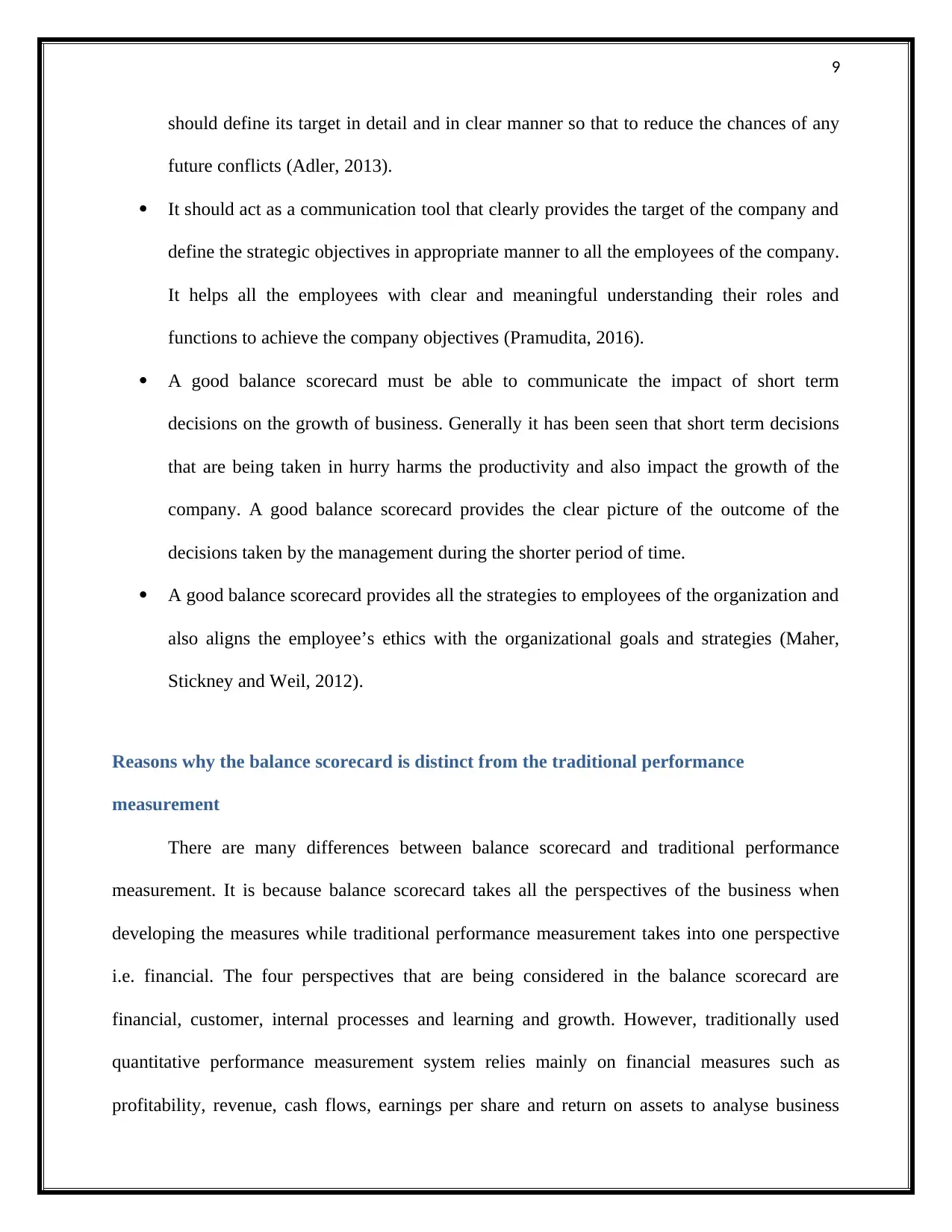
9
should define its target in detail and in clear manner so that to reduce the chances of any
future conflicts (Adler, 2013).
It should act as a communication tool that clearly provides the target of the company and
define the strategic objectives in appropriate manner to all the employees of the company.
It helps all the employees with clear and meaningful understanding their roles and
functions to achieve the company objectives (Pramudita, 2016).
A good balance scorecard must be able to communicate the impact of short term
decisions on the growth of business. Generally it has been seen that short term decisions
that are being taken in hurry harms the productivity and also impact the growth of the
company. A good balance scorecard provides the clear picture of the outcome of the
decisions taken by the management during the shorter period of time.
A good balance scorecard provides all the strategies to employees of the organization and
also aligns the employee’s ethics with the organizational goals and strategies (Maher,
Stickney and Weil, 2012).
Reasons why the balance scorecard is distinct from the traditional performance
measurement
There are many differences between balance scorecard and traditional performance
measurement. It is because balance scorecard takes all the perspectives of the business when
developing the measures while traditional performance measurement takes into one perspective
i.e. financial. The four perspectives that are being considered in the balance scorecard are
financial, customer, internal processes and learning and growth. However, traditionally used
quantitative performance measurement system relies mainly on financial measures such as
profitability, revenue, cash flows, earnings per share and return on assets to analyse business
should define its target in detail and in clear manner so that to reduce the chances of any
future conflicts (Adler, 2013).
It should act as a communication tool that clearly provides the target of the company and
define the strategic objectives in appropriate manner to all the employees of the company.
It helps all the employees with clear and meaningful understanding their roles and
functions to achieve the company objectives (Pramudita, 2016).
A good balance scorecard must be able to communicate the impact of short term
decisions on the growth of business. Generally it has been seen that short term decisions
that are being taken in hurry harms the productivity and also impact the growth of the
company. A good balance scorecard provides the clear picture of the outcome of the
decisions taken by the management during the shorter period of time.
A good balance scorecard provides all the strategies to employees of the organization and
also aligns the employee’s ethics with the organizational goals and strategies (Maher,
Stickney and Weil, 2012).
Reasons why the balance scorecard is distinct from the traditional performance
measurement
There are many differences between balance scorecard and traditional performance
measurement. It is because balance scorecard takes all the perspectives of the business when
developing the measures while traditional performance measurement takes into one perspective
i.e. financial. The four perspectives that are being considered in the balance scorecard are
financial, customer, internal processes and learning and growth. However, traditionally used
quantitative performance measurement system relies mainly on financial measures such as
profitability, revenue, cash flows, earnings per share and return on assets to analyse business

10
performance. The performance assessed by traditional measurement systems does not take into
account non-financial performance measures and therefore provides only a quantitative
assessment. On the other hand, balance scorecard provides both qualitative and qualitative
assessment of performance of a business entity (Niven, 2014).
Traditionally performance measurement systems are not suitable to be applied by the
business organisations in the rapidly changing business environment. This is mainly because
rapidly changing business environment is not adequate for depicting the overall performance of
an organization. As such, the traditionally used systems were not apt for aligning the
performance measurement to strategy and aligning of short and long-term objectives. However,
balance scorecard can be regarded as an efficient tool for linking the organizational strategies
with the business actions and providing an assessment of its overall performance such as
customer relationships, employee and organizational capabilities for achieving success.
Discussion on whether the BSC is suitable to be applied in Woolworths’s
Woolworth’s places large emphasis on implementation and adoption of effective system
and procedures for meeting its strategic aims and priorities. The company aims o deliver
continued value to each of its stakeholder group by effectively aligning with its business
direction. In this context, it needs to implement a performance measurement system for
identifying the business opportunities, introducing new financial products and business practices
for overcoming its weakness and maintaining its continued growth and development plan. The
adoption of an adequate performance measurement system will ensure that the company daily
operational activities are aligned with the business strategies and leading to its long-term growth
and performance (Chavan, 2009).
performance. The performance assessed by traditional measurement systems does not take into
account non-financial performance measures and therefore provides only a quantitative
assessment. On the other hand, balance scorecard provides both qualitative and qualitative
assessment of performance of a business entity (Niven, 2014).
Traditionally performance measurement systems are not suitable to be applied by the
business organisations in the rapidly changing business environment. This is mainly because
rapidly changing business environment is not adequate for depicting the overall performance of
an organization. As such, the traditionally used systems were not apt for aligning the
performance measurement to strategy and aligning of short and long-term objectives. However,
balance scorecard can be regarded as an efficient tool for linking the organizational strategies
with the business actions and providing an assessment of its overall performance such as
customer relationships, employee and organizational capabilities for achieving success.
Discussion on whether the BSC is suitable to be applied in Woolworths’s
Woolworth’s places large emphasis on implementation and adoption of effective system
and procedures for meeting its strategic aims and priorities. The company aims o deliver
continued value to each of its stakeholder group by effectively aligning with its business
direction. In this context, it needs to implement a performance measurement system for
identifying the business opportunities, introducing new financial products and business practices
for overcoming its weakness and maintaining its continued growth and development plan. The
adoption of an adequate performance measurement system will ensure that the company daily
operational activities are aligned with the business strategies and leading to its long-term growth
and performance (Chavan, 2009).
Secure Best Marks with AI Grader
Need help grading? Try our AI Grader for instant feedback on your assignments.
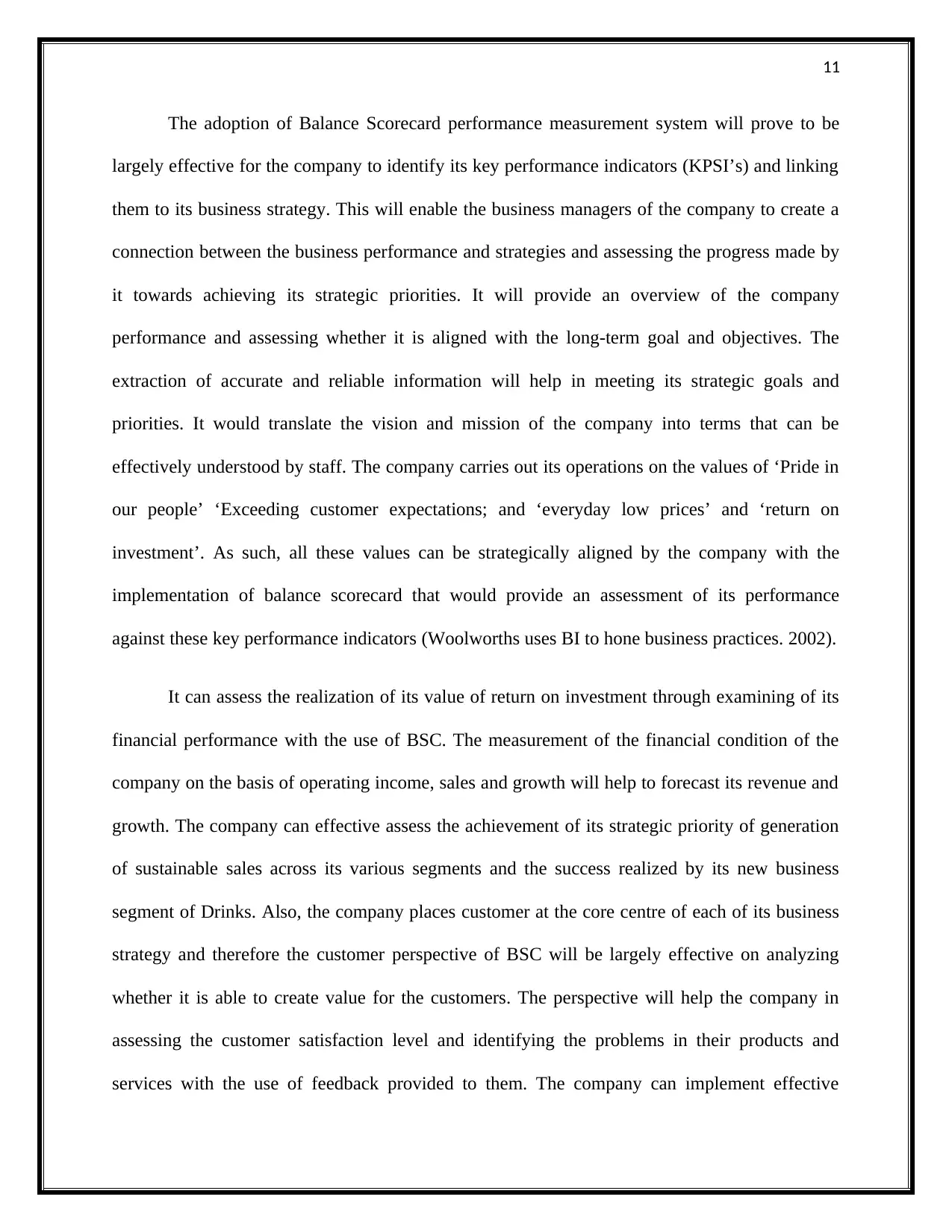
11
The adoption of Balance Scorecard performance measurement system will prove to be
largely effective for the company to identify its key performance indicators (KPSI’s) and linking
them to its business strategy. This will enable the business managers of the company to create a
connection between the business performance and strategies and assessing the progress made by
it towards achieving its strategic priorities. It will provide an overview of the company
performance and assessing whether it is aligned with the long-term goal and objectives. The
extraction of accurate and reliable information will help in meeting its strategic goals and
priorities. It would translate the vision and mission of the company into terms that can be
effectively understood by staff. The company carries out its operations on the values of ‘Pride in
our people’ ‘Exceeding customer expectations; and ‘everyday low prices’ and ‘return on
investment’. As such, all these values can be strategically aligned by the company with the
implementation of balance scorecard that would provide an assessment of its performance
against these key performance indicators (Woolworths uses BI to hone business practices. 2002).
It can assess the realization of its value of return on investment through examining of its
financial performance with the use of BSC. The measurement of the financial condition of the
company on the basis of operating income, sales and growth will help to forecast its revenue and
growth. The company can effective assess the achievement of its strategic priority of generation
of sustainable sales across its various segments and the success realized by its new business
segment of Drinks. Also, the company places customer at the core centre of each of its business
strategy and therefore the customer perspective of BSC will be largely effective on analyzing
whether it is able to create value for the customers. The perspective will help the company in
assessing the customer satisfaction level and identifying the problems in their products and
services with the use of feedback provided to them. The company can implement effective
The adoption of Balance Scorecard performance measurement system will prove to be
largely effective for the company to identify its key performance indicators (KPSI’s) and linking
them to its business strategy. This will enable the business managers of the company to create a
connection between the business performance and strategies and assessing the progress made by
it towards achieving its strategic priorities. It will provide an overview of the company
performance and assessing whether it is aligned with the long-term goal and objectives. The
extraction of accurate and reliable information will help in meeting its strategic goals and
priorities. It would translate the vision and mission of the company into terms that can be
effectively understood by staff. The company carries out its operations on the values of ‘Pride in
our people’ ‘Exceeding customer expectations; and ‘everyday low prices’ and ‘return on
investment’. As such, all these values can be strategically aligned by the company with the
implementation of balance scorecard that would provide an assessment of its performance
against these key performance indicators (Woolworths uses BI to hone business practices. 2002).
It can assess the realization of its value of return on investment through examining of its
financial performance with the use of BSC. The measurement of the financial condition of the
company on the basis of operating income, sales and growth will help to forecast its revenue and
growth. The company can effective assess the achievement of its strategic priority of generation
of sustainable sales across its various segments and the success realized by its new business
segment of Drinks. Also, the company places customer at the core centre of each of its business
strategy and therefore the customer perspective of BSC will be largely effective on analyzing
whether it is able to create value for the customers. The perspective will help the company in
assessing the customer satisfaction level and identifying the problems in their products and
services with the use of feedback provided to them. The company can implement effective
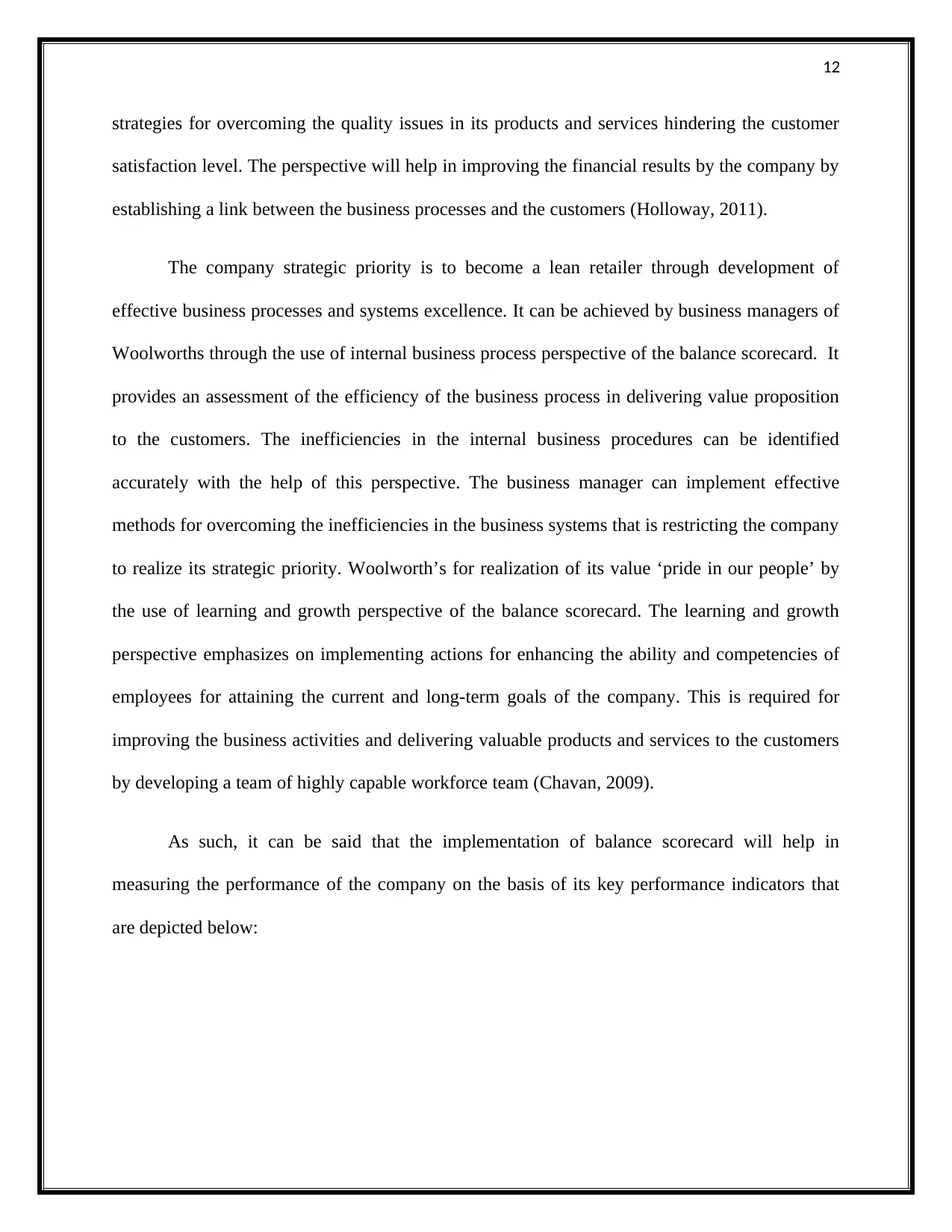
12
strategies for overcoming the quality issues in its products and services hindering the customer
satisfaction level. The perspective will help in improving the financial results by the company by
establishing a link between the business processes and the customers (Holloway, 2011).
The company strategic priority is to become a lean retailer through development of
effective business processes and systems excellence. It can be achieved by business managers of
Woolworths through the use of internal business process perspective of the balance scorecard. It
provides an assessment of the efficiency of the business process in delivering value proposition
to the customers. The inefficiencies in the internal business procedures can be identified
accurately with the help of this perspective. The business manager can implement effective
methods for overcoming the inefficiencies in the business systems that is restricting the company
to realize its strategic priority. Woolworth’s for realization of its value ‘pride in our people’ by
the use of learning and growth perspective of the balance scorecard. The learning and growth
perspective emphasizes on implementing actions for enhancing the ability and competencies of
employees for attaining the current and long-term goals of the company. This is required for
improving the business activities and delivering valuable products and services to the customers
by developing a team of highly capable workforce team (Chavan, 2009).
As such, it can be said that the implementation of balance scorecard will help in
measuring the performance of the company on the basis of its key performance indicators that
are depicted below:
strategies for overcoming the quality issues in its products and services hindering the customer
satisfaction level. The perspective will help in improving the financial results by the company by
establishing a link between the business processes and the customers (Holloway, 2011).
The company strategic priority is to become a lean retailer through development of
effective business processes and systems excellence. It can be achieved by business managers of
Woolworths through the use of internal business process perspective of the balance scorecard. It
provides an assessment of the efficiency of the business process in delivering value proposition
to the customers. The inefficiencies in the internal business procedures can be identified
accurately with the help of this perspective. The business manager can implement effective
methods for overcoming the inefficiencies in the business systems that is restricting the company
to realize its strategic priority. Woolworth’s for realization of its value ‘pride in our people’ by
the use of learning and growth perspective of the balance scorecard. The learning and growth
perspective emphasizes on implementing actions for enhancing the ability and competencies of
employees for attaining the current and long-term goals of the company. This is required for
improving the business activities and delivering valuable products and services to the customers
by developing a team of highly capable workforce team (Chavan, 2009).
As such, it can be said that the implementation of balance scorecard will help in
measuring the performance of the company on the basis of its key performance indicators that
are depicted below:
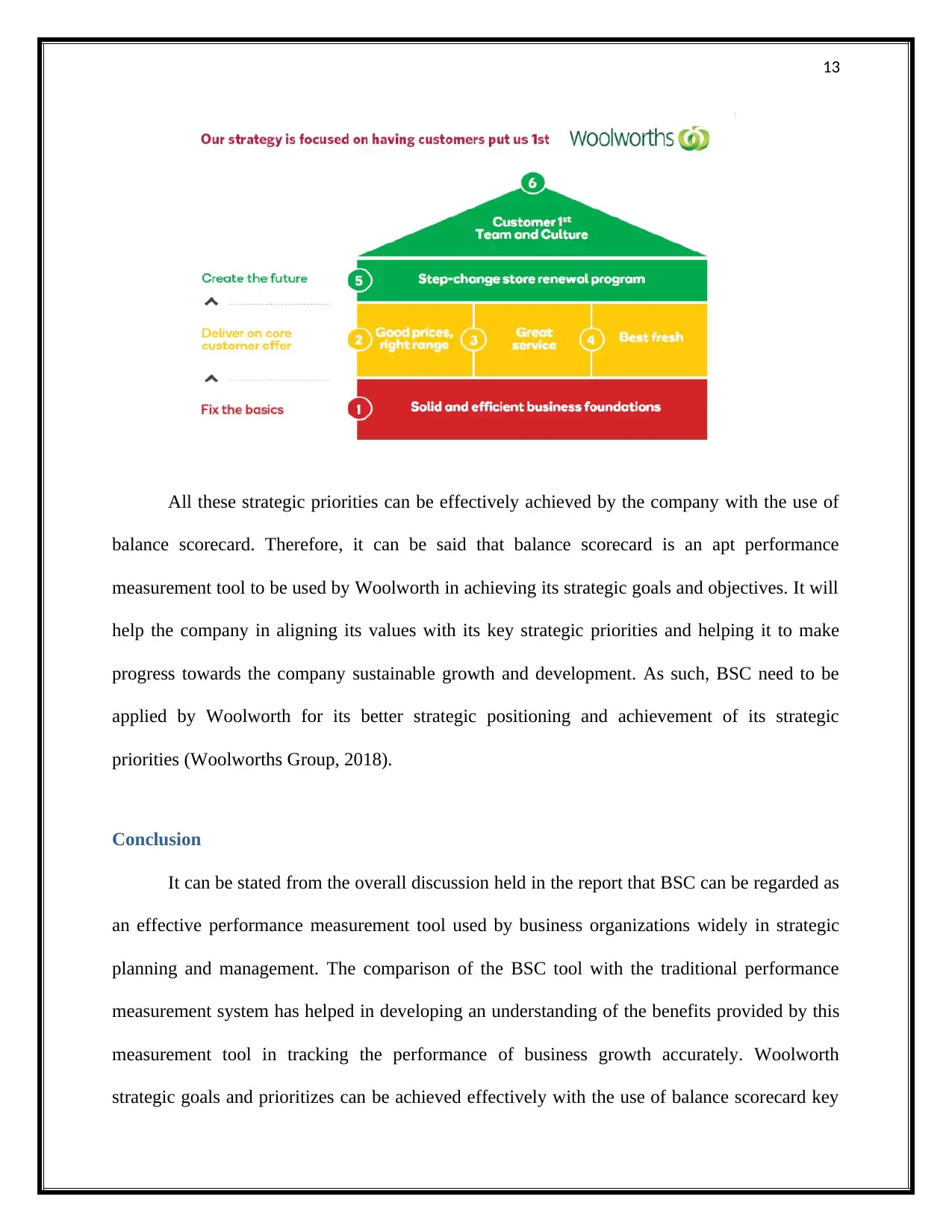
13
All these strategic priorities can be effectively achieved by the company with the use of
balance scorecard. Therefore, it can be said that balance scorecard is an apt performance
measurement tool to be used by Woolworth in achieving its strategic goals and objectives. It will
help the company in aligning its values with its key strategic priorities and helping it to make
progress towards the company sustainable growth and development. As such, BSC need to be
applied by Woolworth for its better strategic positioning and achievement of its strategic
priorities (Woolworths Group, 2018).
Conclusion
It can be stated from the overall discussion held in the report that BSC can be regarded as
an effective performance measurement tool used by business organizations widely in strategic
planning and management. The comparison of the BSC tool with the traditional performance
measurement system has helped in developing an understanding of the benefits provided by this
measurement tool in tracking the performance of business growth accurately. Woolworth
strategic goals and prioritizes can be achieved effectively with the use of balance scorecard key
All these strategic priorities can be effectively achieved by the company with the use of
balance scorecard. Therefore, it can be said that balance scorecard is an apt performance
measurement tool to be used by Woolworth in achieving its strategic goals and objectives. It will
help the company in aligning its values with its key strategic priorities and helping it to make
progress towards the company sustainable growth and development. As such, BSC need to be
applied by Woolworth for its better strategic positioning and achievement of its strategic
priorities (Woolworths Group, 2018).
Conclusion
It can be stated from the overall discussion held in the report that BSC can be regarded as
an effective performance measurement tool used by business organizations widely in strategic
planning and management. The comparison of the BSC tool with the traditional performance
measurement system has helped in developing an understanding of the benefits provided by this
measurement tool in tracking the performance of business growth accurately. Woolworth
strategic goals and prioritizes can be achieved effectively with the use of balance scorecard key
Paraphrase This Document
Need a fresh take? Get an instant paraphrase of this document with our AI Paraphraser
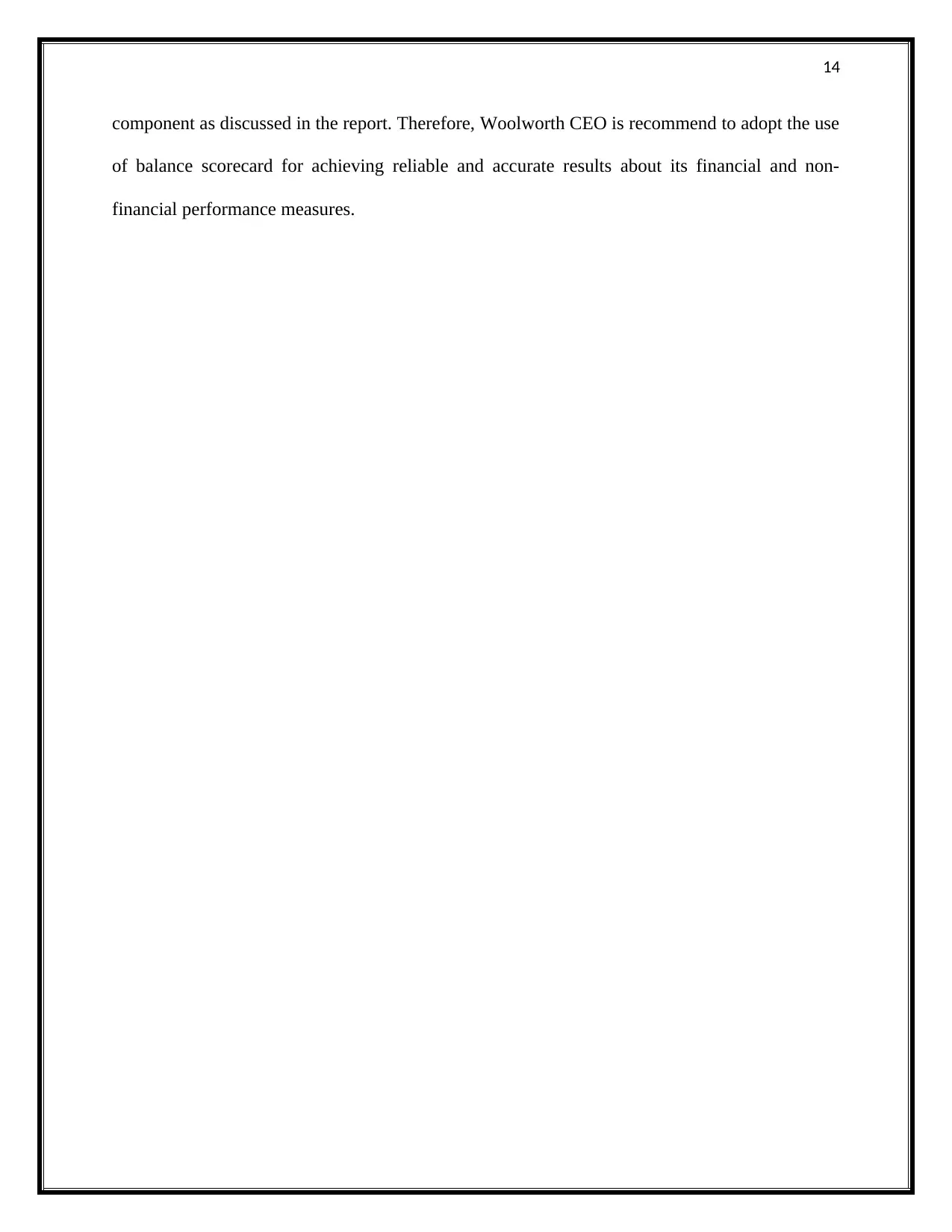
14
component as discussed in the report. Therefore, Woolworth CEO is recommend to adopt the use
of balance scorecard for achieving reliable and accurate results about its financial and non-
financial performance measures.
component as discussed in the report. Therefore, Woolworth CEO is recommend to adopt the use
of balance scorecard for achieving reliable and accurate results about its financial and non-
financial performance measures.
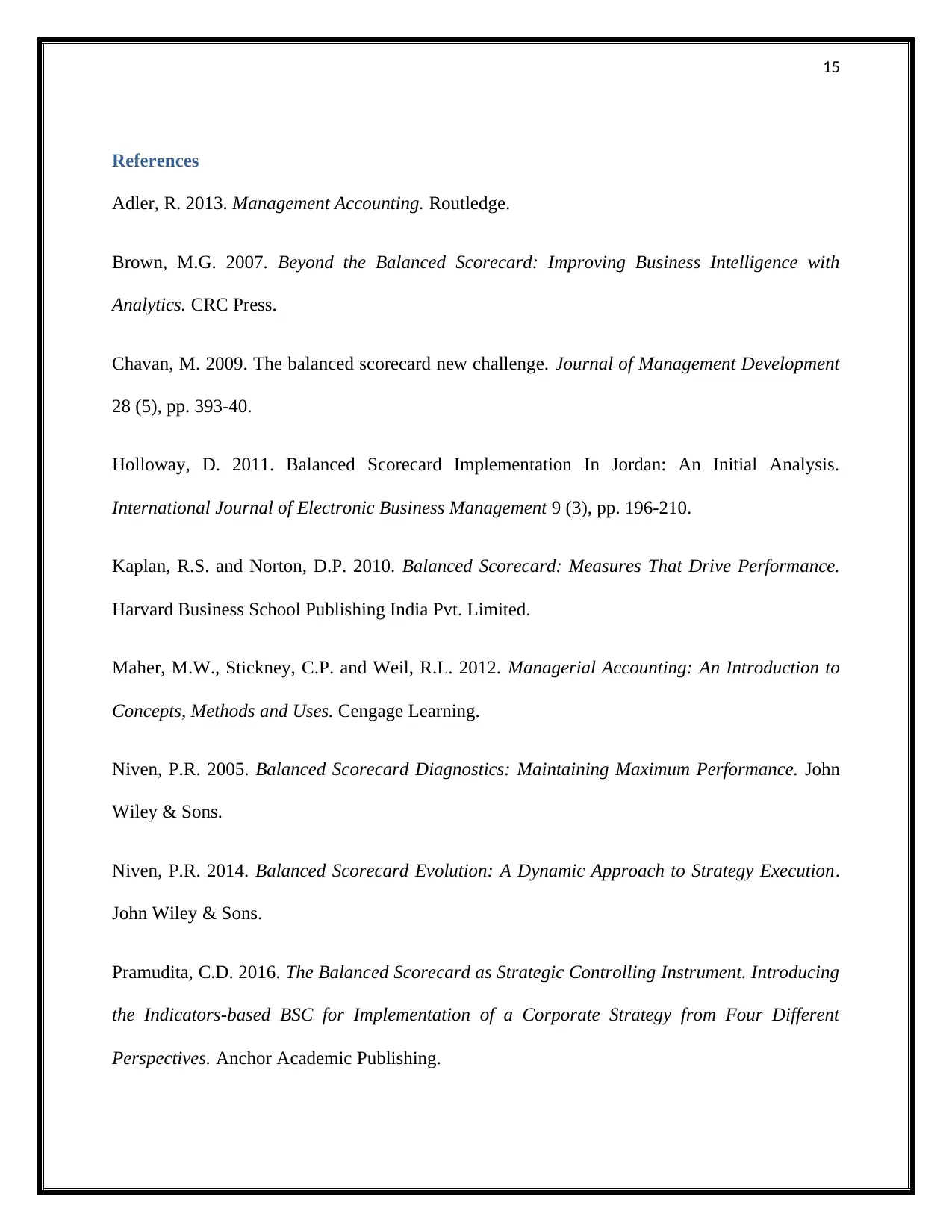
15
References
Adler, R. 2013. Management Accounting. Routledge.
Brown, M.G. 2007. Beyond the Balanced Scorecard: Improving Business Intelligence with
Analytics. CRC Press.
Chavan, M. 2009. The balanced scorecard new challenge. Journal of Management Development
28 (5), pp. 393-40.
Holloway, D. 2011. Balanced Scorecard Implementation In Jordan: An Initial Analysis.
International Journal of Electronic Business Management 9 (3), pp. 196-210.
Kaplan, R.S. and Norton, D.P. 2010. Balanced Scorecard: Measures That Drive Performance.
Harvard Business School Publishing India Pvt. Limited.
Maher, M.W., Stickney, C.P. and Weil, R.L. 2012. Managerial Accounting: An Introduction to
Concepts, Methods and Uses. Cengage Learning.
Niven, P.R. 2005. Balanced Scorecard Diagnostics: Maintaining Maximum Performance. John
Wiley & Sons.
Niven, P.R. 2014. Balanced Scorecard Evolution: A Dynamic Approach to Strategy Execution.
John Wiley & Sons.
Pramudita, C.D. 2016. The Balanced Scorecard as Strategic Controlling Instrument. Introducing
the Indicators-based BSC for Implementation of a Corporate Strategy from Four Different
Perspectives. Anchor Academic Publishing.
References
Adler, R. 2013. Management Accounting. Routledge.
Brown, M.G. 2007. Beyond the Balanced Scorecard: Improving Business Intelligence with
Analytics. CRC Press.
Chavan, M. 2009. The balanced scorecard new challenge. Journal of Management Development
28 (5), pp. 393-40.
Holloway, D. 2011. Balanced Scorecard Implementation In Jordan: An Initial Analysis.
International Journal of Electronic Business Management 9 (3), pp. 196-210.
Kaplan, R.S. and Norton, D.P. 2010. Balanced Scorecard: Measures That Drive Performance.
Harvard Business School Publishing India Pvt. Limited.
Maher, M.W., Stickney, C.P. and Weil, R.L. 2012. Managerial Accounting: An Introduction to
Concepts, Methods and Uses. Cengage Learning.
Niven, P.R. 2005. Balanced Scorecard Diagnostics: Maintaining Maximum Performance. John
Wiley & Sons.
Niven, P.R. 2014. Balanced Scorecard Evolution: A Dynamic Approach to Strategy Execution.
John Wiley & Sons.
Pramudita, C.D. 2016. The Balanced Scorecard as Strategic Controlling Instrument. Introducing
the Indicators-based BSC for Implementation of a Corporate Strategy from Four Different
Perspectives. Anchor Academic Publishing.
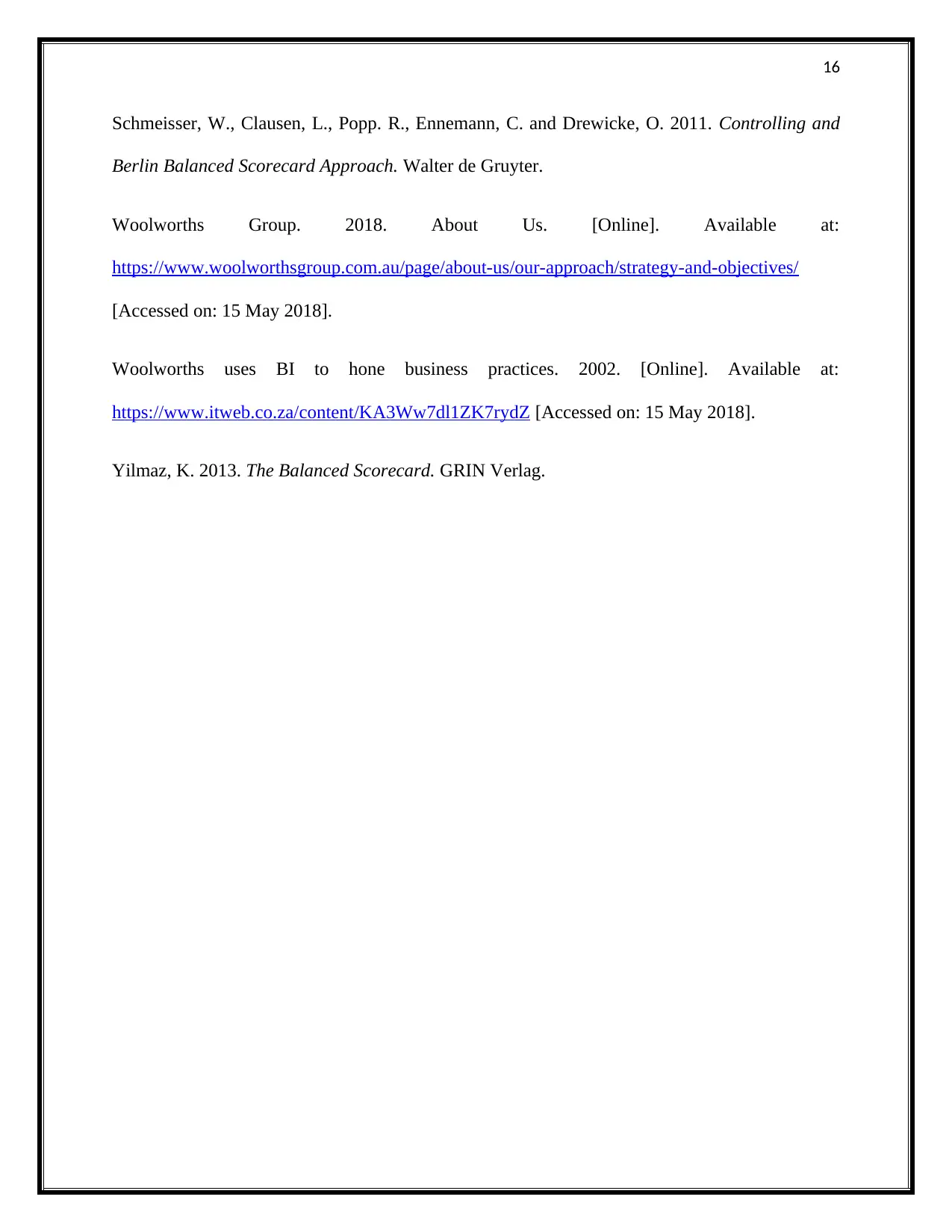
16
Schmeisser, W., Clausen, L., Popp. R., Ennemann, C. and Drewicke, O. 2011. Controlling and
Berlin Balanced Scorecard Approach. Walter de Gruyter.
Woolworths Group. 2018. About Us. [Online]. Available at:
https://www.woolworthsgroup.com.au/page/about-us/our-approach/strategy-and-objectives/
[Accessed on: 15 May 2018].
Woolworths uses BI to hone business practices. 2002. [Online]. Available at:
https://www.itweb.co.za/content/KA3Ww7dl1ZK7rydZ [Accessed on: 15 May 2018].
Yilmaz, K. 2013. The Balanced Scorecard. GRIN Verlag.
Schmeisser, W., Clausen, L., Popp. R., Ennemann, C. and Drewicke, O. 2011. Controlling and
Berlin Balanced Scorecard Approach. Walter de Gruyter.
Woolworths Group. 2018. About Us. [Online]. Available at:
https://www.woolworthsgroup.com.au/page/about-us/our-approach/strategy-and-objectives/
[Accessed on: 15 May 2018].
Woolworths uses BI to hone business practices. 2002. [Online]. Available at:
https://www.itweb.co.za/content/KA3Ww7dl1ZK7rydZ [Accessed on: 15 May 2018].
Yilmaz, K. 2013. The Balanced Scorecard. GRIN Verlag.
1 out of 16
Related Documents
Your All-in-One AI-Powered Toolkit for Academic Success.
+13062052269
info@desklib.com
Available 24*7 on WhatsApp / Email
![[object Object]](/_next/static/media/star-bottom.7253800d.svg)
Unlock your academic potential
© 2024 | Zucol Services PVT LTD | All rights reserved.





